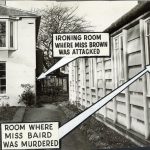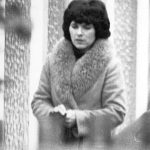
Episode 39 - The Murder Of Stephanie Baird
On December 23, 1959, at 7:44 PM, police in Birmingham were dispatched to the YWCA hostel in Edgbaston after a report from a frightened woman. 21-year-old Margaret Brown explained to the officers she had been ironing in the utility room when she suddenly felt a draught. Upon investigating, Margaret discovered the door in the next room that led outside to the yard was open. Strange, but the young woman didn’t think too much of it. Probably the wind was to blame. So Margaret closed the door and returned to her chores—only to hear the outside door opening again shortly after. This time, someone had also switched off the lights. Confused, Margaret got closer to the glass-paned door. It was then that she noticed a dark figure of a man in the shadow. Before Margaret had time to ask the stranger what he was doing, the man charged at her and hit her on the head with something heavy.
Fortunately, the blow was not strong enough to knock Margaret unconscious, and she was able to let out a bloodcurdling scream. That was enough to scare her attacker, who turned around and ran away.
When the police began their search at the YWCA hostel minutes later, it was quickly realised Margaret Brown had been incredibly lucky to survive the encounter with the unknown man—another young woman did not.
Discovery
The dun-coloured Victorian building that served as the YWCA hostel in Edgbaston, a suburban area of central Birmingham, had 12 separate rooms. At first, the police didn’t really have a reason to investigate the insides of the building—after all, nothing seemed to be out of place or missing and according to Margaret, the attacker had run away immediately after striking her. But when an officer was inspecting the grounds of the hostel, he noticed one of the bedroom windows was open. Concerned that the intruder could have entered the building through the window, the officer looked inside and saw a pair of legs on the floor parallel to the bed.
Police Constable Albert Moore rushed to Room 4, burst open the door that was locked from the inside—and discovered an unimaginably grisly scene that would keep him off work sick for weeks.

For more horrifying true crime stories, please click below:
Archives
The body of 29-year-old Stephanie Baird lay butchered on the floor in a pool of blood, naked and headless. As a Warrington CID officer said, the young woman had “literally been torn to shreds.” As the police later learned, Stephanie had come to Birmingham from the village of Bishop’s Cleeve near Cheltenham, to work as a clerk but was currently unemployed. She had last been seen alive and well just some hours prior to the gruesome discovery when she had left a hairdressing salon near the hostel. How the young woman, who had been packing for a Christmas trip to Scotland, had ended up brutally murdered inside her room without anyone hearing a thing was a mystery.
Stephanie had been sexually assaulted and manually strangled before her head was severed and placed on the bed. The attack had been so vicious that the weapon Stephanie’s killer had used—a blunt, bone-handled table knife—had broken in two. The blood-stained handle was found on the bed next to Stephanie’s head, while the blade itself had been wiped clean. The police estimated that the sadistic murder must have lasted at least 45 minutes—beheading someone with a table knife takes a lot of time.
When the forensic team examined the murder scene, they found no significant fingerprints but discovered size ten footprints both inside room No.4 and on the grounds of the hostel. In addition, Margaret described the suspect to the detectives as around 5ft 8ins tall, aged 25 to 27, with a reddish face, fair hair, and a square chin. The police also found an envelope on top of a wardrobe inside Stephanie’s room with a cryptic message that read:
“This was the thing I thought would never come.”
After writing the sentence, the author crossed out the words. Whether or not the message was written by Stephanie’s killer, it puzzled the police, as did the whole scene.
The young woman’s horrifying murder immediately became the priority. Christmas leave for officers was cancelled as Birmingham CID set up a special headquarters in Speedwell police station with Det Chief Supt James Haughton as the lead of the investigation. Haughton, his deputy Det Supt Gerald Baumber, four detective chief inspectors, eight detective inspectors and a team of officers worked 16-hour days to hunt down Stephanie Baird’s murderer.
Investigation
On the night of December 23, Det Chief Supt Haughton appeared on TV, appealing to the public for information. This was the first time a man in charge of a murder investigation made an appeal on television. Haughton soon became somewhat of a national celebrity due to his repeated appearances and cheerful disposition, which had earned him the nickname “Sunny Jim” among his colleagues and “The Smiling Assassin” among the criminals. But despite the effort, the appeals were to no avail—which was rather strange considering the statement of a conductor of the No.8 inner circle bus.
Just before 8 PM on the night of Stephanie’s murder, a young man wearing a brown, hip-length duffel coat boarded No. 8 without saying a word to the conductor. He handed over sixpence and sat down upstairs, where he was later seen talking with two other men. The threes eventually got off in the Small Heath area without anybody trying to stop the young man, whose coat and hands were heavily bloodstained.
Following the conductor’s account, the police toured the area and continued to appeal for witnesses—but no one came forward despite the fact there had been at least 50 people inside the bus at the time.
Without the police having an obvious suspect in the case or even a person of interest, Birmingham was quickly named “Terror City” by London’s sensationalist press. Because the killer had not just murdered a young woman but also attacked another, everyone feared he would strike again. Nurses on the night shift in all local hospitals were not allowed to travel to work and back home alone but were escorted in special buses. The Aston Villa soccer team even cancelled their out-of-town match because the wives of the team members would have been left home alone—it was too big of a risk with the killer at large. Meanwhile, the London Daily Mirror published an article shaming the people who had been riding on the bus that night and failed to report a bloodstained man to the police. Chief Superintendent Haughton’s appeals to the passengers were repeated over the radio, on TV, and even flashed on the screens of cinemas but with poor results. By Sunday, four days after the brutal murder, only one of the witnesses had come forward.
Eventually, a few other passengers contacted the authorities, just to tell the detectives they did not see a bloodstained man on bus No. 8. However, the police learned that a homeward-bound worker had noticed a young man slumped against the wall at the Lee Bank Road bus stop in Birmingham around 7:45 PM, just moments after Stephanie’s death. The young man had filthy clothes and tangled blond hair—but despite his messy appearance, he was not drunk. Instead, the man explained he had fallen, saying he would be just fine as soon as he got on the bus.
The most vital witnesses, the two men that had been talking with the suspect and a man and a boy who had allegedly refused to sit down on the bloodied seat after the young man left, were never heard from. It was difficult to comprehend why these people chose not to come forward, especially due to the nearly $17,000 reward. Of course, the passengers may have been scared to get involved—but it was also speculated that because the bus was filled with people from a rougher area of Birmingham, they simply were not friendly with cops. Or, perhaps the passengers thought because there were so many individuals on the bus that night someone else would contact the authorities anyway and they didn’t have to, as a form of the bystander effect. Whatever the reason was, the police desperately needed a break to move forward with the investigation. It took almost a month, but that break finally came on Tuesday, January 19, 1960.
Patrick
That day, Pc Mike Davey called an address in Islington Row on house-to-house inquiries and discovered something suspicious. On December 23, on the day Stephanie Baird was strangled to death and beheaded, a 28-year-old man named Patrick Joseph Byrne had been lodging at this house—but on Christmas Eve, he had suddenly returned to his parents’ place in Birchall Street, Warrington. Islington Row was only half a mile away from the YWCA hostel.
PC Davey immediately had a bad feeling. The police had already made house-to-house inquiries and Patrick’s absence had not been noted by his associate. Still, it was just a feeling and nothing else suggested this man actually had anything to do with Stephanie’s murder. Nevertheless, the Warrington Police were asked to trace Patrick Byrne and interview him just in case. At this point, he was about to be just one of approximately 20,000 men the police had talked with during the investigation. That, however, changed quickly.
That Tuesday, Patrick was taken to the station on Arpley Street. He was acting somewhat nervous straight from the beginning but then again, “anybody who comes into a police station is a little bit nervous.” But when Det Sgt Graham Henry Wellborn asked Patrick about fingerprints, the young man started shaking and soon admitted:
“I want to tell you about the YWCA. I had something to do with that, it has been on my mind.”
After weeks without progress in the case, a confession was incredible—but Patrick could have also simply been a fantasist. So, Det Sgt Wellborn called Birmingham police, who instructed him to ask Patrick questions that only the real killer could answer—and he did.
After being questioned by Det Supt James Haughton, Patrick Byrne was taken to Birmingham to face trial for the murder of Stephanie Baird.
Apparently, Patrick had a history of secretly watching women for his pleasure—but on the evening of December 23, 1959, things got out of hand. That day, Patrick had been drinking with four other men before noticing Stephanie, who was walking back to the hostel. Patrick followed the young woman and watched her getting undressed through a window. That evening, only looking wasn’t enough to satisfy Patrick so he broke into Stephanie’s room and asked for a kiss. Needless to say, Stephanie refused with fatal consequences as her killer explained to the police:
“She screamed and I put my hands round her neck. She went backwards inside the room with me squeezing her throat. I was lying on top of her kissing and squeezing her at the same time. I heard a couple of small noises from her throat but kept on kissing her.“
Upon realising his victim was dead, Patrick picked up a bread knife and mutilated Stephanie’s body. He also admitted to writing the message on the envelope and was able to describe Stephanie’s clothes and room No. 4 to the police. After leaving the room through the window, Patrick saw Margaret, who attracted him which is why he decided to murder her too. Allegedly, Patrick went back to his lodgings after the failed second attack and wrote a note to his landlord claiming he had two personalities before tearing the paper to pieces. Experts later described Patrick as a sexual psychopath, but it was determined he was not legally insane.
Patrick Byrne was eventually convicted of Stephanie Baird’s murder on March 24, 1960, at Birmingham Assizes and was sentenced to life imprisonment. But despite the fact Patrick confessed and his shoes matched the footprints found at the scene and the case is solved and closed, there is still something that remains a mystery. Patrick denied being the taciturn stranger wearing a hip-length duffel on bus No. 8 on the night of the murder. If he was telling the truth as he was with everything else, who was the bloodstained man?
Episode Credits:
Host – Rhiannon Doe
Voiceover – Kwesi
Website layout & design – Fran Howard
Sources:
THE MURDER THAT SHOCKED THE MIDLANDS Dateline
Foreign News: The Man on Bus No. 8
Midlands News: 10.02.1960: Stephanie Baird Murder
The gruesome murder and the trail that led to Warrington














